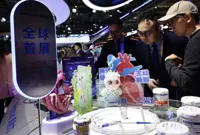Fresh start: A worker dismantles the Twitter sign at its corporate headquarters in San Francisco Musk renamed Twitter as X and unveiled a new logo. — Reuters
I SUPPOSE you could say changing the Twitter bird logo to an “X” makes complete sense. As the recognised icon for “make it go away”, X just about sums up the achievements of Elon Musk’s social network so far.
Gone are many of Twitter’s users, half of its advertisers, 80% of its employees and its operational stability.




